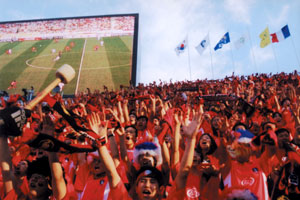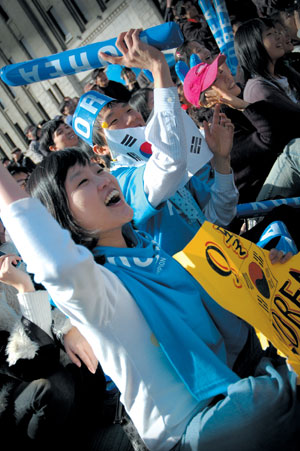An analysis of Korea's cheering culture
IT'S BEEN four years since Korea's City Hall was filled with people wearing red t-shirts, screaming a"Daehan Mingook." The place was crowded with people eager to witness the victory of our Korean Soccer Team. The world's media was amazed by Korea's passionate cheering. As an ordinary high school freshman, I didn't have the slightest interest in soccer until the 2002 World Cup. However, I soon came to know all the famous star players. Looking back, I think I was just thrilled to participate in cheering and sharing in an once-in-a-lifetime exciting experience with my friends, rather than actually being interested in soccer. Was I the only one to get so overwhelmed in this situation? Well, I don't think so!
The uniqueness of Korean Cheering 
▲ The Red Devils cheering wildly wearing red t-shirts.
(The Annals Archives)
The 2002 Korea-Japan World Cup can be classified as the first breakout of Korea's cheering culture. The entire world was amazed, almost shocked by the immense number of people gathered in the same place, all wearing red t-shirts. Also, people yelling "Daehan Mingook" (meaning Republic of Korea) in rhythmic unison attracted the attention of many. As Korea's soccer team moved closer to overall victory, more and more people participated in the cheering, so companies and broadcasting stations set up stages in front of City Hall where they broadcast the games. Companies were launching World Cup-related advertisements and marketing campaigns. For example, KTF and Pizza Hut gave out free pizza when the team qualified for tournaments.
The cheering culture can be classified as an enjoyable part of culture since people gain pleasure through it. Cheering exists almost everywhere in the world in differing forms and formats. Beyond just ordinary people cheering for their favorite teams, a lot of countries have their own cheering culture. In England, crazed fans or "hooligans" are known for their aggressive cheering. Also in the US, cheerleaders' performances are common at sports games. However, among these performances there is nothing like Korea's immense organized cheering.
Korea's first large-scale cheering culture was peculiar because it was a new experience for many, if not all. The media focused on Koreans' energetic performances and people were also surprised with their own enthusiastic behavior. People of all ages enjoyed and celebrated the festivities and during this period, the whole country acted as if it was bouncing on top of the clouds. Various types of cheering aids appeared, such as "thunder sticks", towels, stickers, and whistles. A new style of fashion was even created by using Taeguk-gi, the national flag of Korea. This liberal atmosphere made people able to enjoy and create a new culture of their own. "I can't forget when I was out in Gwanghwa-moon screaming and clapping 'Daehan Mingook.' I can remember so clearly how people were thrilled when Korea's team earned their first victory," recalls Jin Yoo-jeong (Soph., Dept. of Food & Nutrition).
A Psychological View "An individual can act more freely when they are in a group" Cheering is seen in a very different light through the lens of psychology. First, the main purpose of cheering is because people simply want to have fun. The level of enjoyment depends on the individual, but fundamentally the main goal is to enjoy and take part in the passionate atmosphere. Second, an individual can act more freely when they are in a group, rather than when alone. This is called the "Crowd-Mindset Phenomenon." People have a tendency to be less shy and inhibited if they are in a group, so they act more openly. Lastly, a tendency to find enjoyment in groups rather than by one's self boosts the overall cheering energy. This is an effect that can be phrased by the well-known saying "Good things multiply when shared among people." People gather in groups to celebrate and to make a more enthusiastic atmosphere. During this process, people can share the same feelings and really have the impression of belonging to a certain group. A Sociological View "Cheering enables us to release our latent desire for amusement" I would like to focus on the fact that this cheering took place in an open area, such as City Hall and Gwanghwa-moon, which acted as focal meeting points. We live in a city, however we barely communicate with each other. Our daily lives do not allow us to easily make deep relationships. This affects people negatively because they can't share their true feelings with others. Human beings need to interact with each other openly but this is nearly impossible in our disconnected society. Intimate relationships with a few people often isn't enough to fulfill our needs. The majority of the relationships that we make are more superficial than meaningful. Individuals feel lonely and isolated even if they live in a crowded city. The 2002 World Cup gave people the opportunity to communicate and share the same feeling as a collective group. Although the person sitting next to you at City Hall wasn't someone you knew before, you were able to celebrate the desire for and the happiness of Korea's victory together. Another important point of this phenomenon is that we were able to release our latent desire for amusement. Considering the fact that Korean society was controlled by a military government, which put limits on enjoying things such as music, books, and dramas until the 1980s, people didn't have the chance to completely enjoy and celebrate their inner passions.
Why do we cheer? 
-Interview with Prof. Suh Eun-kook (Dept. of Psychology)
What's the meaning of this phenomenon? 
- Interview with Prof. Kim Chan-ho (Dept. of Sociology)
Minor factors and goals of cheering culture 
▲ A couple at City Hall cheering for Korea? baseball team with eye-catching cheering equipment.
(Photographed by Chai Kyu-min)
At the time of the 2002 World Cup, the fierce enthusiasm seemed endless. Nevertheless, people, media, and companies all suddenly calmed down and returned to normal life as soon as the festivities ended.
The recent WBC (World Baseball Classic) cheering that took place at City Hall on March 19,2006 wasn't as exciting or as well-attended as four years ago. Even when considering the fact that the weather was too cold and the characteristic of baseball differs from soccer, the atmosphere on March 19 was still too different from the past. This may be an example of cheering's fading popularity in our society.
Also, for the past four years, the majority of people's interest was focused on the 2002 World Cup cheering and they tried to maintain the excitement of that moment. People seemed unable to move on from that because the experience had stimulated them too much. This made them rely on the cheering methods of 2002 at every event without developing new ways. These can be the fundamental difficulties in our cheering culture. The problem is that people do not continue to properly develop the cheering culture started by the 2002 World Cup.
As mentioned above, our unique Korean cheering traditions can be classified as an entertainment aspect of culture. Unlike Western countries where individualism is widespread, Korean people tend to seek fun in groups, due to cultural traditions. However, because Korea is short on ways to have fun, there aren't enough ways to satisfy their needs. For example, people do not have enough activities or adequate facilities to have fun on weekends or during their free time. Especially teenagers and company workers have trouble finding leisure opportunities anywhere other than PC rooms, karaoke clubs, and movie theaters. Small group activities may give positive influences on people rather than just doing things alone. For example, local festivals for students, families, and friends to attend and enjoy will offer people more chances to have fun.
Considering the facts above, our society needs to make an effort to maintain the cheering culture in the right way because it is one of the methods by which we as a society can gain pleasure and unity. "The most important aspect in cheering is how much we feel delighted by participating," says Lee Doo-ho (Representative of the Red Chickens). "The Red Chickens was first organized in 2002 to enjoy soccer games with people eating chicken with the name 'Daksamo' (People who love chicken). The main purpose was to have fun and I continue to carry on in this spirit. Also, there shouldn't be anyone isolated from enjoying festivals. Individuals' spontaneous participation is very meaningful because that means people's cultural integration has been improved throughout the years."
Interview - Yonseian's Cheering Ahn Young-kyun, Yonsei Yell Leader (Soph.,Dept. of Business Admin.) Han Ha-nui (Soph., Area of Social Science)
Yon-Ko Fete has a high reputation throughout Korea for its games and peculiar cheering culture that exists only at Yonsei and Korea Universities. The Yonsei Annals asked Yonseians and the Yonsei Yell Leader about what specialities Yonsei cheering has.
I think cheering helps us love our school, Yonsei. Also, I feel proud to be a Yonseian when cheering and we are more united when we cheer. I think it's the best way to get rid of stress.
Spontaneous participation is the answer 
▲ A crowd cheering for their team, Suwon Samsung, by throwing confetti.
(Photographed by Kim Young-sung)
Recently, Summit Dance, introduced by actor Kim Soo-rho, found popularity among netizens. There have been talks of making this dance an official dance for the 2006 Germany World Cup. The interesting thing is that this movement wasn't influenced by an external force; it was carried out by citizens themselves. If we create an association to support these people who are willing to volunteer themselves, we will likely have a more amazing cheering culture.
A huge number of people at City Hall on March 19, 2006 cheering for Korea? baseball team during the WBC.

